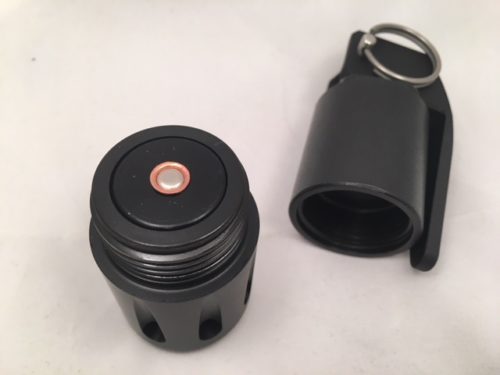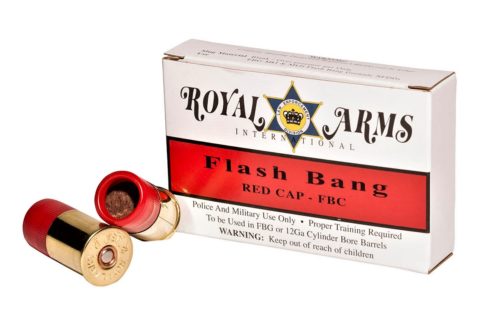A municipality may be held liable for a violation of rights that results from a failure to adequately train its employees if that failure represents a deliberate indifference on the part of the municipal policy.

The use of a “flashbang” device is neither per se objectively reasonable nor unreasonable. The reasonableness of its use depends on the facts and circumstances of each case. It cannot be reasonable absent a strong governmental interest, careful consideration of alternatives and appropriate measures to reduce the risk of injury.
A legally defensible policy and proper training are key to the safe and effective employment of flashbangs. Most of the injuries that occur are the direct result of operator error. Operator error can almost always be linked to a failure in training. Training not only saves lives, it’s your first line of defense in court. As we all know, training must be thoroughly documented. If it’s not documented, it didn’t happen.
The buzzword in training today is reality-based training. Of course, reality cannot be replicated in a training environment. The goal in training must therefore be realistic simulation. For training to be meaningful, it must be as close to reality as possible. A lack of meaningful training and not just a lack of training can constitute a deliberate indifference to a known risk.
In the past, options were limited when it came to flashbang training. Standard flashbangs were and are expensive and impose restrictions on the training environment. This led many teams to employ expended flashbangs for training.
Today, there are a variety of training devices available that are designed to realistically simulate the characteristics of standard flashbangs. Training flashbangs fall into three categories — inert, pyrotechnic and non-pyrotechnic (pneumatic). They replicate to varying degrees the handling characteristics of standard flashbangs without the cost and regulatory requirements.

The Royal Arms International FBG-MK3 NFDD Flash Bang Trainer™ has a number of unique features that set it apart from other flashbang training devices on the market today. It’s an upgraded version of Royal Arms now discontinued FBG-MK2, which itself replaced Royal Arms original flashbang training device, the FBG-MK1.
The FBG-MK3 is what’s known as a Blank Firing Impact Grenade (BFIG). It’s set off by impact, instead of employing a time delay fuze. It’s not the only impact initiated training flashbang on the US market, but it’s the only one that’s deployed in a similar manner (i.e. pull ring and spoon) to a standard flashbang.
Designed specifically for training purposes, it’s hand-deployed in the same manner as a standard flashbang. The FBG-MK3 contains a mechanism that fires a blank cartridge (either a special 12 gauge blank or a standard 209 shotshell primer) when the device is deployed from a height of about one meter onto a hard surface (which activates the inertia driven firing system).
The FBG-MK3 features a number of design improvements over its predecessor, the FBG-MK2. Royal Arms uses durable impact-resistant heat-treated tool steel for the FBG-Mk3. They have increased the impact strength and abrasion resistance by more than 700%.
Royal Arms also increased the structural integrity of every internal component in all the critical areas. The chamber threads have been switched from a Metric fine thread to a Quick Lock Acme Stub that acts as a sealed breech upon assembly but allows the user to easily disassemble once initiated. The new Acme thread has 300% more thread engagement yet screws together in half the amount of turns compared to the FBG-MK2
As with its predecessor, the side ports on the chamber on the FBG-MK3 are fluted to redirect gases upon firing in order to help retard propulsion of the device when the 12 gauge blanks are employed. It utilizes the same spoon, which was redesigned on the FBG-MK2, for easier and more consistent release. It also has the dual pin safety of the FBG-MK2, which is designed to allow it to continue to be employed safely in the advent of the loss of the spoon.

Also as with its predecessor, the FBG-MK3 has a single universal chamber. It uses a special insert (included) to employ 209 primers instead of the FBC Cartridge 12 gauge blanks.
The size and weight of the FBG-MK3 are identical to its predecessor, as well. The FBG-MK3 measures 4.5 inches (11.43 cm) long and weighs 300 grams (10.58 oz.). It’s shorter in length than the ALS, CTS and Def Tec devices commonly employed in the US. It replicates the Nico and other European devices.
Standard-size flashbang pouches can be used with the FBG-MK3, but work best if a spacer is placed in the bottom of the pouch to elevate the device in the pouch. It also fits well in most 40mm munitions pouches.
The chamber of the FBG-MK3 is designed so that it cannot accommodate standard 2 ¾-inch (70 mm) 12 gauge shells. However 1.75-inch (44.5 mm) 12 gauge Mini shotshells will fit in the chamber, with potentially disastrous results if deployed. Mini shotshells are becoming more widely available, so extra caution must be exercised.

The FBG-MK3 has been designed for maximum safety. The cross-pin block prevents any movement of the firing pin toggle. The cross-pin block features a spring-loaded ball detent that acts as a secondary safety, preventing the cross-pin block from being accidentally released. The firing pin toggle is also protected from impact by the spoon. The firing pin is of inertia design. It has a single conical 6 lb. spring.
The ball detent serves the same purpose as the angular spread on the split-end pin of a conventional fuzed grenade / flashbang, making it harder to pull so that it won’t be pulled out accidentally. I would have preferred a somewhat larger diameter pull ring, especially since gloves will be worn. This is a minor critique and easily remedied by the end user as it’s a standard split ring.
The Royal Arms 12 gauge blanks produce 175 dB at 5 feet (1.5 m), 4 psi of overpressure and a bright 500,000+ candela flash. The 209 primers produce 118 dB at 5 feet, roughly equivalent (to the ear) of the output of a small firecracker.
For most training scenarios, the 209 primer will be the loading of choice. For those training scenarios in which it’s desirable to have an output that approximates a standard flashbang, the 12 gauge blanks can be employed. With the blanks, the cost is less than $4 per deployment, which is significantly less than fuzed training flashbangs,

The 209 primers definitely are the most cost effective way to conduct flashbang training, running only around 5¢ each. You won’t find any flashbang training system that can even come close to that, save for inert flashbangs. The costs on competing systems can quickly add up.
The 209 primer is loud enough for effective training, but still hearing-safe. This makes it ideal for role-playing scenario-based / force-on-force training. Operators don’t need to be subjected to unnecessary hearing damage or overpressure. Plus, training can be conducted in more locations than would be possible with a higher output.
Keep in mind that dBs are measured by what’s known as a “logarithmic function.” Short term unprotected exposure to SPL exceeding 130 dB may result in mechanical cochlear damage to the human ear. Although no permanent hearing loss should result from a single exposure to a flashbang, the effects of loud noises are cumulative and irreversible.
The FBG-MK3 is user serviceable and reloadable. Loading and reloading takes only seconds. The spent 12 gauge hulls sometimes do stick in the chamber, requiring the use of a special extraction tool (which is included) to push them out. No tool is necessary with the 209 primers, which always drop free.

The FBG-MK3 “blows” where you throw. You can deploy it against any hard object, such as a floor, wall, ceiling, window, slider, second story, car door, etc. It won’t start fires, is cool to the touch immediately after firing and produces minimal smoke.
Testing
Although I have not yet had the opportunity to test the new FBG-MK3, I did extensive testing of its predecessor the FBG-MK2, which has the same size, weight, firing mechanism and porting of the FBG-MK3. During my testing, there were no failures when the device was deployed within its intended design parameters. The only failures to fire occurred when the device was deployed outside those parameters, e.g., deploying it on soft ground.
Collateral effects (fire, movement and disruption of objects) by the device were also tested. There wasn’t any fire start from the tests, as determined by the presence of open flame after testing, using potentially flammable household objects placed (clothing, furniture, paper, etc) within the expected functional region of the device. There wasn’t any movement of the device with the 209 primer. When employing the 12 gauge blanks, the device was propelled approximately two meters upon firing, although the velocity wasn’t sufficient to pose any safety hazard.
There wasn’t any disruption of collateral objects within the functional range with the 209 primer. There was minimal disruption with Royal Arms 12 gauge blanks. Disruption was noted by movement of any objects from their origin. No fragments were generated with either the 209 primers or 12 gauge blanks. Impacts sized greater than 0.25 inch were counted in this test. There was minimal smoke with the 12 gauge blanks and no smoke with the 209 primers. Due to the similarity between the two devices, I don’t expect there to be any difference in these results with the FBG-MK3.

Low-Cost Training
The FBG-MK3 makes truly low-cost flashbang training a reality. A pack of one hundred 209 primers runs just five bucks or less if you shop around. Buy in bulk and you will save even more. Budgetary constraints no longer need to limit the use of flashbangs during training.
The 12 gauge blanks and 209 primers ship as a ORM-D Consumer Commodity, the same as standard ammunition. UPS Ground and FedEx Ground don’t require a hazardous shipping contract to ship ORM-D packages (except to Alaska and Hawaii). This further keeps costs down.
The FBG-MK3 is NOT considered a Destructive Device by the ATF. As such there are not any special storage, transportation, handling or accounting/record keeping requirements.
For hand-deployment training applications in which cost is an issue (and when is cost not an issue?) the FBG-MK3 is hard to beat. It’s already eliciting considerable interest from agencies.
That said, no device is without its limitations. The FBG-MK3 is no exception. The FBG-MK3 must be deployed on a hard surface for reliable operation. Since it’s impact fired and not fuzed, it isn’t suited for bang pole training applications. It’s obviously also not suited for use in training as a trip-wire booby-trap or command initiated training device. For the latter training applications, a fuzed pyrotechnic training device, command initiated pyrotechnic training device, or a non-pyrotechnic (pneumatic) training device should be employed.
Summing It All Up
To sum it all up, the Royal Arms FBG-MK3 is an excellent, cost effective training tool. It provides tactical teams with an exceptionally low-cost training device that to a large extent realistically simulates the functional characteristics of a standard flashbang. It allows teams to train more often, in more places, and with much greater safety.
MSRP of the FBG-MK3 is $299.00. This may at first seem expensive but, factoring in the per use cost, the money you save in one training session alone could quite easily pay for the FBG-MK3. There are a number of major agencies that are already employing Royal Arms Flashbang Training System. Contact Royal Arms for details.
The FBG-MK3 is 100% made in America, by Americans (ex military, SF & LE). It’s covered by a two-year unlimited use warranty.
The FBG-MK3 is available for immediate shipping. LE/MIL/GOV sales only. Active, reserve, retired, and trainers with valid credentials. Credentials will be verified prior to shipping. No ATF approval is required.
*The views and opinions expressed on this website are solely those of the original authors and contributors. These views and opinions do not necessarily represent those of Spotter Up Magazine, the administrative staff, and/or any/all contributors to this site.

